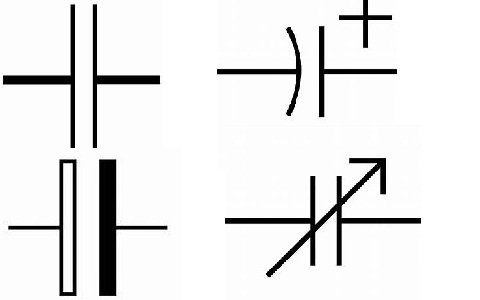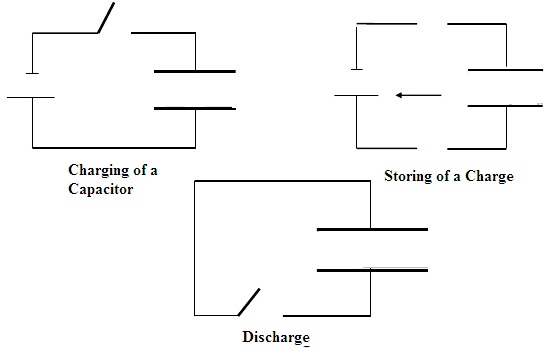Capacitors are the basic element of any circuit that requires the smoothening of signals. These elements are widely preferred for the blocking of the DC signals. Whenever a capacitor is supplied with the DC voltage the positive charge is settled at one side of the plate. The remaining negative charges are shifted at another plate. In this way, the charges have attained a state of stability. Hence the positive and the negative charges neutrally arranged on the plates.
This is the reason when the capacitor gets supplied with DC it gets charged. No evident flow of current is observed in such cases. When the capacitor supplied with the AC the current flow can be observed in the circuit. These are available in small forms as well as large forms based on the requirements.
What is a Capacitor?
A component that is designed with the separation of parallel plates in which the material of insulation is present. This material is known as Dielectric. This type of component is defined as a capacitor. The meaning that defines the name capacitor is, to store the charges in terms of the electric field.
Capacitor Symbol
A capacitor consists of two plates that are parallel to each other. In the same way, the symbol represents the plates along with the separation. Even two end terminals that are used in the circuit connections can be shown in the symbol. These capacitors are available in various symbols and types. These can be in the shapes of the rectangle, it can be a square, spherical, cylindrical or circular.

Various Symbols of Capacitors
Working :
The two plate’s devices when connected to the supply of the voltage. Let us consider the supply is of DC. The positive terminal of that used battery will be connected to one plate and the negative terminal of it is connected to the other end of the plate. The electrons that are negatively charged tend to flow the from positive terminal of that battery to the negative one.
But due to the presence of insulating material called dielectric in between the plates the charges cannot pass through it. Instead of flowing it gets settled at the other side of the plate. Now one of the plate has more number of electrons accumulated. This indicates that the capacitor is charged. Only the charging is possible with when a DC supply is applied.

Capacitor working
The important point to be considered is that in the capacitors when the applied or the supply of the voltage is equal to the voltage at charging. Even though the battery is provided it stops getting charged. Due to this even if the battery is removed the charge that is present in the capacitor is stored. But If we replace a battery with a load the capacitor gets discharged.
Instead of DC if the capacitor is provided with the AC supply in this case both the halves of the cycles are present. Due to this reason, the capacitor faces both the phenomenon of charging and the discharging. Because positive half of the supply makes the capacitor to get charged and negative half makes the capacitor gets discharged.
In the case where AC supply is provided the Charging and the Discharging are dependent upon the frequency of the source signal. This is the basic principle involved in the functioning capacitor.
Why Capacitors are Important?
The capacitor is the capable passive element that is used in various electronic systems. Some of the importance requirements of the capacitor is illustrated below :
- These are the components that are good enough at storing the charges. Even at the necessities the charge can be utilized or dissipated in the circuit.
- Capacitors are preferred during the coupling of the circuits.
- It can be used during the amplification of a certain range of frequencies.
- In the applications of power, the utilization of this capacitor makes it more Economical.
- In the applications of filtering where it is required to make the generated signal ripple-free, capacitors are preferred.
- In the application that relates to power supply units, these capacitors are preferred.
- Even in the practical example, if you observe, in the photographs with flash the capacitors play a vital role.
In this way, this component called a capacitor is utilized in the systems where either Dc or Ac supplies are present. In the various systems, these are utilized randomly.
The Capacitance of a Capacitor
The property or the ability of the capacitor to store the amount of the charge within it can be defined as the capacitance of the capacitor. The physicist called Michael Faraday is the person behind the detailed study of capacitors. The units of the capacitance can be denoted in terms of FARADAY.
Let us consider one volt of the supply is provided to the capacitor such that one coulomb of the charge has flowed. Hence the capacitance of one Farad is generated in it. The value of the capacitance is dependent on the shape and the material used in the construction of the capacitor. Even the type of dielectric also affects capacitance.
The charge is present on both the plates. This charge can be denoted as ‘Q’. There exists some value of the difference in the potential across the plates denoted by ‘V’. Therefore the value of capacitance of a particular capacitor can be defined by the ratio between the charge existing and the difference in potential created.
C= Q/V
Where “C” in the equation determines the value of the capacitance to the Charge and the Potential Difference across the plates. It is evident from the equation that Capacitance is directly related to charge in the capacitor and inversely related to the Potential Difference. Hence by increasing the plates in number one can increase the value of its capacitance. But the area of that capacitor will be incremented.
Capacitor Formula
The formula of the capacitor based on the permittivity can be written as

Where “C” is the capacitance denoted in terms of farads.
Standard Units of Capacitance
Generally, the capacitance value is measured in terms of Farads. But this is the large unit. Instead of this, its sub-units are used in various cases. These are widely preferred in the Real-Time Applications. The subunits are “milli farads (mF), micro-farads, nano-farads (nF) and picofarads (pF)”. To convert the value of one unit into another unit a converter referred to as “Electrical Capacitance Unit Converter” is used.
- 1 milli farad (mF) = 10^-3 F = 1000 micro F = 10^6 nF.
- 1 micro farad = 10^-6 F=10^3 nF =10^6 pF.
- 1 nano farad (nF) = 10^-9 F = 1000 pF.
- 1 pico farad (pF) = 10^-12 F.
The above units are considered as the Standard Units which are preferred in the various applications.
Voltage Rating of a Capacitor
The performance of this component is determined by the rating of the voltage. Each capacitor has its rating of voltage. This rating is provided during the manufacturing time. This plays a major role to determine the performance of the system. Like every component even the capacitor has a certain limited rating that is further exceeding the voltage may destroy the component.
Capacitor operates in three modes based on which the voltage rating of a capacitor can be chosen. When there is no supply provided the capacitor has remained at uncharged mode. Once the supply is provided the capacitor functions in such a way that it gets charged. While charging as it reaches the maximum rating based on the load connected the capacitor enters into discharging mode.
The main important factor n which the voltage depends upon is the dielectric material used in between the plates of the capacitor. There is a term relates to voltage known as let u. The maximum rating is chosen in such a way that it must possess the Working Voltage 50 percent more than the applied Maximum Voltage in the circuit. In the case with DC, it doesn’t get affected. But AC has an RMS factor.
Applications :
The applications of these component are as follows:
- In the amplification circuits, the capacitors are included to permit Ac signals and block Dc.
- These are used as Couplers. To couple the different circuits.
- These are also used as decouplers. This prevents fluctuations in voltage. It even reduces the noise factor in the circuits of Power Supply.
- To smoothen the signals generated at the output.
- To use as a tuner in the radios, any other transmitters … these capacitors are preferred.
In this way, there are various capacitors are used based on the required applications.
There are various applications of the capacitors in the practical world. As we know that it has two plates that are parallel to each other. But when the other plate is inserted between these plates and connected in such a way that it establishes the connection with the ground. The capacitance of that capacitor can be reduced to value zero. let us know How will you identify which type of capacitor is used in the circuit?